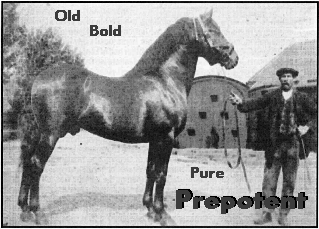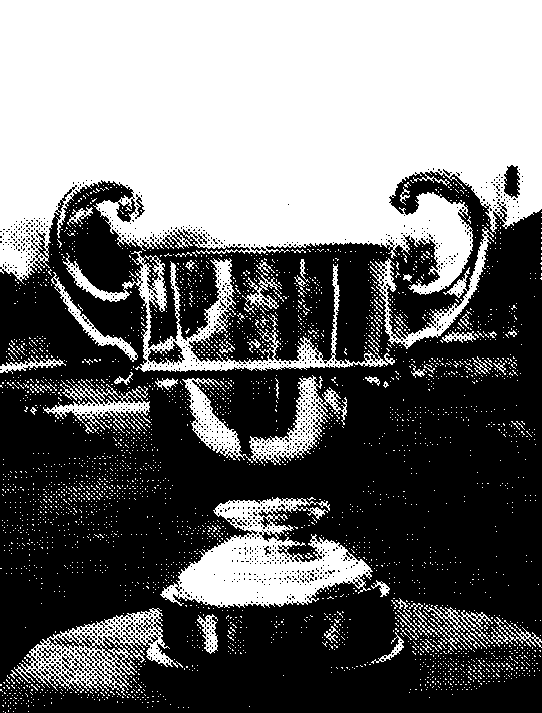
Grange Lad, foaled 1916. Photo used with permission of the Cleveland Bay Horse Society.
[A Breed Apart | Early History | A Rare Breed | Breed Characterisics | The Royal Mews | Breed Organizations | Breed Standards ]
by Linda Yaciw
The Cleveland Bay is the oldest established breed of English horse and is known as an English Warmblood.
In 1884, the Cleveland Bay Horse Society of Great Britain published the first volume of its Stud Book, with entries going back to 1860, containing stallions and mares selected for purity of blood, many of whose pedigrees traced back over a century. Several mares were entered who had eight generations of back breeding shown on the dam's side.
Cleveland Bays are one of the few "pure" breeds, with no recent outcrosses. In consequence, Cleveland Bays stamp their get with remarkable uniformity of size, conformation, soundness, stamina, disposition and color.
|
Grange Lad, foaled 1916. Photo used with permission of the Cleveland Bay Horse Society. |
The Cleveland Bay is unique in its carefully maintained purity. While the warmbloods of France, Germany, Sweden, Poland, Hungary and other European countries have produced a number of good individuals, their pedigrees are riddled with recent Thoroughbred, Arabian and other outcrosses. It is interesting to note that the Cleveland Bay was used extensively last century to improve the European breeds! Registration in the European warmblood studbooks carries with it no guarantee or even probability that their offspring will inherit their excellence with any consistency. Currently several of the Continental breeds, having lost their own foundation stock by too much cross breeding, are coming to the Cleveland to reintroduce bone and substance.
The experience of centuries has shown that, above all else, the value of the Cleveland Bay lies in its prepotency. The Cleveland Bay's accomplishments and their prepotency prompted their use as foundation stock or improvement sires for the Oldenberg, Hanovarian, Anglo Norman (Selle Francais), Holsteiner, Clydesdale, and other breeds.
The Cleveland Bay breeds true. Foals resemble very closely their dam and sire; each foal is very similar to each other. Breeders with a large foal crop sometimes have problems distinguishing one foal from another. Horses are identified on their registration papers by their whorls.
The ancestors of the Cleveland Bay, known as Chapman horses, can be traced to the selective breeding practices by a far-sighted Abbott in the Cleveland hills (North Yorkshire, England) in 1231, where they were kept as a breed apart. Over the centuries of breeding, only minimal additions of outside blood have been allowed, this being the Barb and some Andalusian, both from the mid 1500's to 1600's.
North Yorkshire is also the origin of the Thoroughbred. This county, from about 1660 to 1740, by breeding desert-bred imported Arabian stallions to native British race mares, the D'arcys of Sedbury, the Darleys of Aldby, and other breeders, evolved the race horse now known as the Thoroughbred.
Between 1707 and 1780, thirty-two of the first offspring of the Arabian foundation sires of the Thoroughbred (the original, oriental type) were bred to Cleveland Bay mares.
It is certain that after the 18th century there was no other infusion of alien blood. By then the Cleveland had emerged as an unmistakably fixed type.
The Cleveland Bay is on the endangered species list. In the 1950's there were only four purebred stallions and 5 of their offspring left in the entire world. Queen Elizabeth II intervened and purchased a stallion, Mulgrave Supreme, who had been destined for export to the United States. He was made available to breeders of pure and partbred Clevelands with enormous success. Within 15 years of his purchase, the number of stallions in Britain had increased to 36, sixteen of which were the progeny of Mulgrave Supreme.
There are approximately 500 Cleveland Bays worldwide. In 1996 there were 53 purebreds in North America (including five in Canada), and several thriving studs in New Zealand, Pakistan and Australia, and the bulk of them (350 or so) in Britain. There are several in Japan as well: the Imperial Household has been importing CBs for many years.
The Clevelands Bay is known as the great improver, or up-grader, of other breeds. They are in demand for cross-breeding with Thoroughbreds to produce 3-day eventers (dressage, field jumping, show jumping), jumpers and dressage horses. They are most well-known as coach horses.
During the war years, the Cleveland Bay was the favored breed for war use. The British War Office offered a premium to Cleveland Bay stallions: many Cleveland Bays and CB partbreds were produced and were put into war service. During the two World Wars, approximately 1.5 million horses died. (On the Western Front alone, the Allied losses were 48,000 horses each month of all breeds.) Many of those horses that died were Cleveland Bays. It is interesting to note that the British War Office only discontinued its premiums to stallions in 1960.
Thus the Cleveland Bay has three reasons for its decline, two of which are directly related to the popularity of the breed:
Today, the Cleveland Bay is still heavily cross-bred with Thoroughbreds, and to many other breeds to a lesser extent.
In the 1960's, the Cleveland Bay started to make its come-back when the age of the recreational horse took hold. In 1983, the first purebred Cleveland Bay foal was born in the United States, after a hiatus of 25 years. However, in 1994, only 22 purebred fillies were registered world-wide.
Yorkshire Coach Horse
With the introduction of macadamised roads, the Cleveland Bay was considered not fast enough, and as a result the Yorkshire Coach Horse came into being. In 1887 a Yorkshire Coach Horse Stud Book was introduced, which contained horses that were three-quarters Cleveland Bay and one-quarter Thoroughbred. The Stud Book was closed in 1936 with the decline of the coaching era. Since the foundation breeds of the Yorkshire Coach Horse still exist, it would be possible to re-start this breed.
The Cleveland Bay is noted for its sturdy legs and large, tough "blue" hooves. The cannon bone is flat-front, 9" minimum. Cleveland Bays mature between 6 and 7 years, and are very long-lived. They will sometimes have a very pronounced Roman nose, which derives from the Iberian influence. The Cleveland Bay is hardy and is an easy keeper considering its size.
The Cleveland Bay is native to an area with an abundance of gumbo clay and water with a high iron content. The Cleveland was used for farming in this heavy clay land and it could haul very heavy loads in deep going. Today, the Cleveland has established itself as a heavy hunter able to jump out of clay almost from a standstill. A trait that lends itself well to the jumping disciplines is the boldness of the breed. The breed is also noted for its endurance ability, and its exceptional disposition. The British War Office prized this horse for war use because of its strength, endurance, hardiness, disposition, tractability and unflappability.
There have been many individual records, old and new, that have proved the abilities claimed for the breed. For example, consider the ancient achievement of a CB mare, "Fanny Drape", who jumped in-hand a 7.5-foot bar. These horses are known to be "full of courage" Fanny Drape was eventually asked to attempt the impossible and she broke her back trying. Cleveland Bays are natural jumpers, and they excel at verticals. The Cleveland and its crosses have a long history of records and accomplishments, some of which relate to world championships, including the Olympics.
The Cleveland Bay also has a reputation as a western horse. According to one American in 1940 (when there were more CBs and CB crosses in America than there are now), whose father owned a large ranch in the West and several hundred head of horses, there was "Among the stallions... one Cleveland Bay and, of course, he was bred to all kinds of range mares, but he turned out some of the best saddle horses in the country." He said they were capable of carrying a 200 pound cowboy plus all his equipment through a full day of roundup and stock work. "They had a lot of staying quality, were easy keepers and it took a Thoroughbred to outrun one in a race. It took a big steer on the end of a rope to even worry one of the partbred Cleveland saddle horses," he said.
One great admirer of the breed was Buffalo Bill, who imported many Clevelands into the United States.
The Cleveland Bay remains a superb crossing horse to breed hunters and competition horses for all the disciplines, and a part-bred registry is maintained so that horses may be traced and followed during their careers. Prince Phillip's very successful team of International Carriage Driving horses is an Oldenburg/Cleveland Bay cross. The Queen is patron to the Cleveland Bay Horse Society and was its President in 1984. Lt. Col. Sir John Miller, the former Crown Equerry, was President from 1987-89. Though retired from the Royal Mews, he is in charge of the Royal Stud at Hampton Court, where purebred Cleveland Bays are once more being bred.
The breed has long enjoyed royal patronage. George II was an enthusiast and King George V owned and/or breed 26 partbreds and five purebreds.

[ Top | A Breed Apart | Early History | A Rare Breed | Breed Characterisics | The Royal Mews | Breed Organizations | Breed Standards ]
Suggest you read Cleveland's Rock next.
e-mail: lyaciw@pris.bc.ca